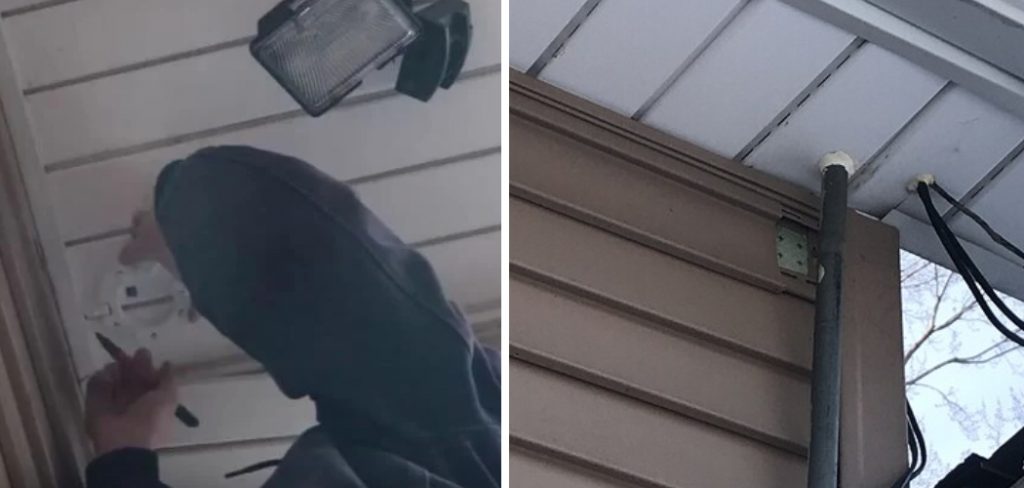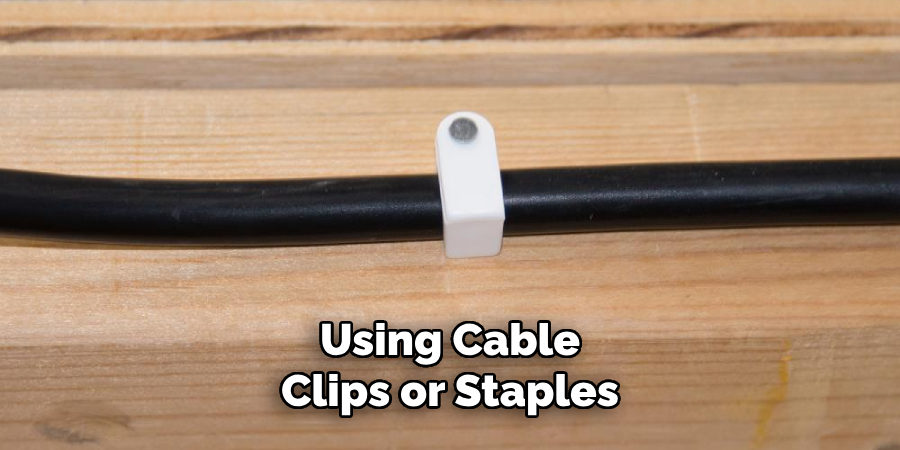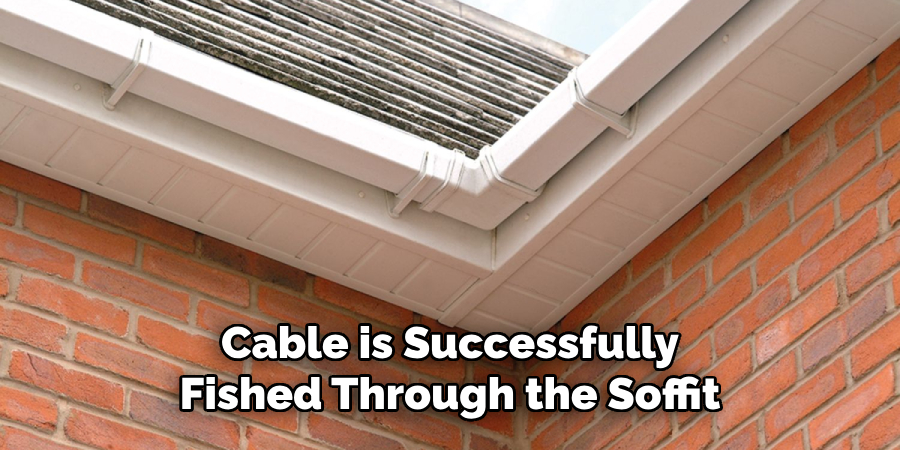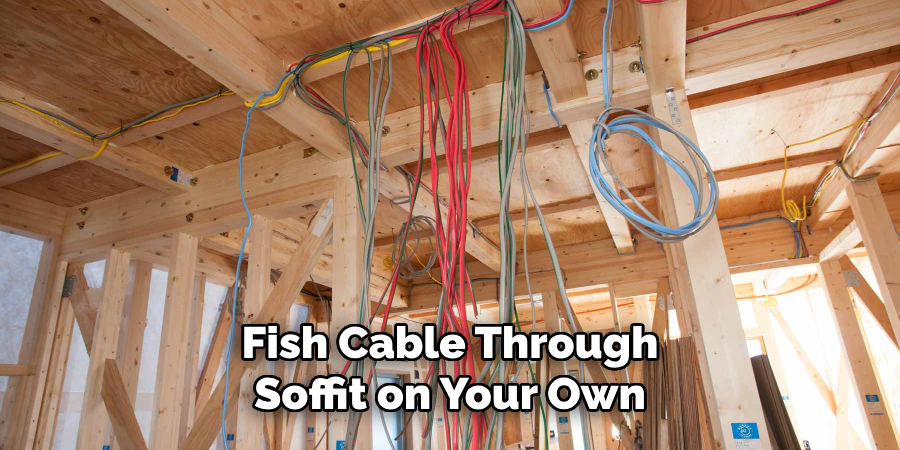If you’re a DIY enthusiast looking for a challenge, fishing cable through the soffit can be a great way to take on an interesting project. With the right knowledge and skillset, it’s a manageable task that anyone with even moderate home improvement experience should be able to accomplish.

Fishing cable through soffit is far from impossible; in fact, with our step-by-step guide on how to fish cable through soffit, we’ll show you just how easy it can be!
We explain everything from what type of cable and tools will work best to getting inside the wall—all in one comprehensive article that’ll make running your cables look like child’s play.
So if you’re ready to start taking on bigger projects as part of your next home renovation or upgrade venture, then get comfortable and keep reading — this guide has got all the information (and more!) that you need!
Tools and Materials You Will Need to Fish Cable Through Soffit
- A cable (ideally outdoor-rated)
- Drill with a long drill bit
- Fish tape or electrical wire
- Tape measure
- Stud finder
- Safety equipment including gloves and goggles
Step-by-step Guidelines on How to Fish Cable Through Soffit
Step 1: Determine the Location for Cable Entry
Before you get started with a fishing cable through your soffit, it’s important to determine where exactly you want the cable to enter. This will help you plan out the rest of the process and ensure that everything runs smoothly. It’s also a good idea to confirm that there are no obstructions in the wall or attic before you begin.
Step 2: Prepare Your Cable
Next, prepare your cable by stripping off about 6 inches of the outer jacket and pulling out the wires inside. This will make it easier to fish through the soffit and ensure that the cable is not too thick for the space.

Preparing your cable before you start will save you time and frustration later on. This is also a good time to attach the fish tape or electrical wire to your cable, which will make it easier to thread through the wall.
Step 3: Locate Your Attic Space
Carefully locate and access the attic space above where you want your cable to enter. This will give you a better view of how the cables run in your house and help you determine the best path for your cable. If necessary, use a stud finder to locate any obstructions in the wall and avoid running into them. make sure that the area is well-lit and clear of any debris or obstructions.
Step 4: Drill a Hole in the Soffit
Once you’ve determined the location for your cable entry, it’s time to drill a hole through the soffit. Carefully measure and mark where you want your hole to be, making sure it lines up with your desired cable entry location.
Use a drill with a long bit to make the hole, making sure to keep the drill level and steady. Once you’ve made the hole, make sure it’s big enough for your cable, and use sandpaper to smooth out any rough edges.
Step 5: Thread the Cable
Using either fish tape or electrical wire, thread your cable through the hole you just drilled and into the attic space. It may take a few tries to get it right, but with some patience and maneuvering, you should be able to successfully thread your cable. Make sure to pull enough cable through so that you have plenty of slack to work with.
Step 6: Pull the Cable Through
Once your cable is threaded through the soffit and into the attic, you can start pulling it through to the desired location. Use caution and take your time to make sure you don’t damage the cable or any other wires in the process. If necessary, use electrical tape to secure the cables together as you pull them through.
Step 7: Secure Your Cable
Once your cable is pulled through, secure it using cable clips or staples to keep it in place. This will prevent any potential damage or tripping hazards, and ensure that your cable is neatly installed. While securing the cable, make sure to avoid any electrical wires or other obstructions in the attic.

Step 8: Connect Your Cable
Lastly, connect your cable to its intended destination, whether it’s an outlet or another device. Make sure all connections are secure and tight before turning on power to test your new cable installation. Once everything is connected and working properly, you can sit back and enjoy your newly installed cable!
Following these step-by-step guidelines, fishing cable through soffit can be a manageable and rewarding task. With the right tools and knowledge, you’ll be able to successfully complete this project and add a new skill to your DIY repertoire.
So go ahead and give it a try – just make sure to follow safety precautions and take your time for a successful outcome.
Additional Tips and Tricks to Fish Cable Through Soffit
1. If you are planning to fish cable through the soffit, it is important to have the right tools on hand. The most commonly used tools for this task include fish tape, steel wire, and electrical tape.
2. Before starting the process of fishing cable through the soffit, ensure that you have properly planned out the route that the cable will take. This will help avoid any obstacles or difficult turns while fishing the cable.
3. When using a fish tape, make sure to attach the cable securely to one end of the tape before feeding it through the soffit. This will prevent the cable from slipping off and getting lost in the soffit.
4. To make it easier to feed the cable through tight spaces, bend the fish tape at a right angle before inserting it into the soffit. This will help navigate through corners and obstacles more easily.
5. If you are working with an existing cable that needs to be replaced, consider using the old cable as a guide for the new one. Simply attach the new cable to the end of the old one and pull it through as you remove the old cable.
6. To make the task of fishing cable through the soffit less strenuous, consider using a pulley system. This involves attaching a pulley to one end of the cable and pulling it through from the other end with another tool.
7. If you encounter any sharp edges or corners while feeding the cable through the soffit, protect it by wrapping electrical tape around those areas. This will help prevent any damage to the cable.
8. If you are working with a long cable, it may be helpful to have an extra set of hands to pull the cable through while you guide it from the other end.
9. Always use caution when working with electrical cables and make sure that all power sources are turned off before starting the task.
10. Lastly, if you are unsure about how to fish cable through the soffit or encounter any difficulties, it is always best to seek professional help. It is important to prioritize safety and avoid any potentially hazardous situations.

Following these tips and tricks can make the process of fishing cable through the soffit more efficient and hassle-free. With the right tools, planning, and precautions, you can easily complete this task and have a properly installed cable in no time. So go ahead and tackle that next home improvement project with confidence! Happy fishing!
Precautions Need to Be Followed for Fishing Cable Through Soffit
1. First and foremost, before you begin fishing a cable through the soffit, it is extremely important to turn off the power supply to the area where you will be working. This will ensure your safety and prevent any potential electrical hazards.
2. Before starting the process, make sure to take accurate measurements of the length of cable needed for your specific project. This will help avoid unnecessary wastage of cable and ensure a smooth installation process.
3. It is recommended to use fish tape or a similar tool specifically designed for fishing cables through tight spaces. This will make the task easier and prevent any damage to the cable or surrounding structures.
4. Inspect the soffit area thoroughly before beginning, making sure there are no obstructions or potential hazards such as sharp edges or loose wires.
5. When fishing the cable through the soffit, make sure to carefully guide it through without forcing it too much. This could cause damage to the cable or the structure and may result in an unsuccessful installation.
6. If necessary, use lubrication such as silicone spray or electrical tape around the end of the cable to help ease its passage through the soffit.
7. In case of any resistance or difficulty, do not pull or tug on the cable forcefully. Instead, reevaluate the situation and try to find a better angle or approach for fishing the cable through.
8. Once the cable is successfully fished through the soffit, make sure to secure it properly using clips or staples to prevent it from getting damaged or tangled.

Following these precautions will ensure a safe and successful installation of your cable through the soffit. Remember to always prioritize safety and take necessary measures to prevent any accidents or damage. Happy fishing!
Frequently Asked Questions
What is a Soffit?
A soffit is the underside portion of a roof or eave that extends beyond the exterior wall of a building. It can also refer to the material used to cover this area.
Why Would You Need to Fish Cable Through Soffit?
Fishing cable through soffit is a common practice when installing wiring for outdoor lighting, security cameras, or other devices that require power and connectivity. It allows for a cleaner and more discreet installation compared to running the cable along the exterior of the building.
Can I Fish Cable Through Soffit on My Own?
While it is possible to fish cable through soffit on your own, it is recommended to hire a professional for this task. Working with electrical wiring can be dangerous and should only be done by someone with the proper knowledge and experience.

What If I Have Existing Wiring in My Soffit?
If you already have existing wiring in your soffit, it is best to consult with a professional before attempting to fish new cable through. They will be able to assess the situation and determine the best course of action for safely installing the new cable without causing any damage or interference with the existing wiring.
Conclusion
All in all, knowing how to fish cable through soffit is a valuable skill for any homeowner or handyman to have. It allows for a clean and professional-looking installation that can add functionality and convenience to your outdoor space. Remember to always prioritize safety first and consult with a professional if needed. Happy fishing!
About
Safety Fic is a distinguished figure in the world of Diy design, with a decade of expertise creating innovative and sustainable Diy solutions. His professional focus lies in merging traditional craftsmanship with modern manufacturing techniques, fostering designs that are both practical and environmentally conscious. As the author of diy, Safety Fic delves into the art and science of Safety Fic-making, inspiring artisans and industry professionals alike.
Education RMIT University
(Melbourne, Australia) Associate Degree in Design (Safety Fic) Focus on sustainable design, industry-driven projects, and practical craftsmanship. Gained hands-on experience with traditional and digital manufacturing tools, such as CAD and CNC software.
Nottingham Trent University
(United Kingdom) Bachelor’s in diyfastly.com and Product Design (Honors) Specialized in product design with a focus on blending creativity with production techniques. Participated in industry projects, working with companies like John Lewis and Vitsoe to gain real-world insights.
Publications and Impact
In diy, Safety Fic his insights on indoor design processes, materials, and strategies for efficient production. His writing bridges the gap between artisan knowledge and modern industry needs, making it a must-read for both budding designers and seasoned professionals.
